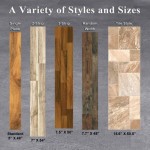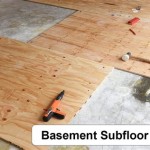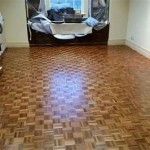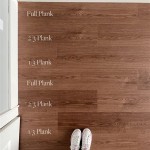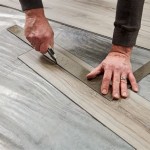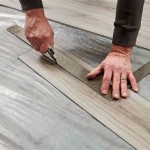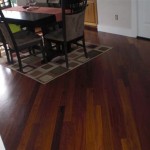Will Double Sided Carpet Tape Damage Hardwood Floors In House?
The question of whether double-sided carpet tape will damage hardwood floors is a common concern for homeowners. Hardwood floors represent a significant investment, and maintaining their pristine condition is a priority. Double-sided carpet tape is frequently used to secure rugs, runners, and carpets to prevent slipping and bunching, improving safety and aesthetics. However, the adhesive properties of the tape, combined with the nature of hardwood finishes, can potentially lead to various forms of damage. This article will explore the potential risks associated with using double-sided carpet tape on hardwood floors, examining the different types of tape, the types of damage that can occur, and strategies for minimizing or preventing these issues.
Hardwood floors are typically finished with a protective coating that shields the wood from scratches, stains, and wear. Common finishes include polyurethane, varnish, lacquer, and penetrating oils. These finishes vary in their durability, resistance to chemicals, and ease of maintenance. The interaction between the adhesive in carpet tape and these finishes is a crucial factor in determining whether damage will occur. Some adhesives can react with certain finishes, causing discoloration, softening, or even complete removal of the coating. In addition to the finish, the type of wood used for the flooring also plays a role. Softer woods, like pine, are more susceptible to damage from the adhesive than harder woods, like oak or maple.
The type of double-sided carpet tape used is also a critical consideration. Carpet tapes vary significantly in their adhesive strength, composition, and intended use. Some tapes are specifically designed for use on delicate surfaces and are labeled as "removable" or "residue-free." These tapes typically use a weaker adhesive that is less likely to damage the finish. Other tapes are designed for heavy-duty applications and have a much stronger adhesive, which poses a greater risk of damage. The backing material of the tape can also contribute to damage. Certain backings can be more aggressive than others, leading to scratching or abrasion of the floor surface during removal.
Potential Damage Mechanisms
Several mechanisms can cause damage to hardwood floors when using double-sided carpet tape. Understanding these mechanisms is essential for making informed decisions about tape selection and application. The primary concern is the adhesive itself, which can chemically interact with the floor's finish. Many carpet tapes use aggressive adhesives to ensure a strong bond, and these adhesives can contain solvents or chemicals that soften or dissolve the finish over time. This softening can result in discoloration, dulling, or even complete removal of the finish, leaving the wood exposed and vulnerable to further damage.
Another potential damage mechanism is physical damage during tape removal. When tape is forcibly removed from the floor, it can pull away the finish along with it. This is particularly common with tapes that have a very strong adhesive or when the tape has been in place for an extended period. The longer the tape remains adhered to the floor, the stronger the bond becomes, and the greater the risk of damage during removal. In some cases, the tape can even pull up small pieces of the wood itself, resulting in permanent gouges or splinters in the floor.
Residue left behind by the tape is also a significant concern. Even "removable" tapes can sometimes leave a sticky residue on the floor surface. This residue can attract dirt and grime, leading to discoloration and staining. Removing the residue can also be difficult and may require the use of harsh chemicals or abrasive cleaning methods, which can further damage the finish. The type of residue left behind can vary depending on the tape's composition, but it is often a persistent problem that requires specialized cleaning techniques.
Factors Influencing the Likelihood of Damage
Several factors influence the likelihood of double-sided carpet tape damaging hardwood floors. The type of finish on the floor is a crucial factor. Polyurethane finishes, known for their durability and resistance to chemicals, are generally more resistant to damage from carpet tape than other types of finishes, such as wax or shellac. However, even polyurethane finishes can be damaged by aggressive adhesives or prolonged exposure. The age and condition of the finish also play a role. Older finishes that are already worn or damaged are more susceptible to further damage from carpet tape.
The type of carpet tape used is another significant factor. Tapes with strong, aggressive adhesives are more likely to cause damage than tapes with weaker, removable adhesives. It is essential to carefully read the product labels and choose a tape that is specifically designed for use on delicate surfaces. The length of time the tape remains on the floor also affects the likelihood of damage. The longer the tape is in place, the stronger the bond becomes, and the greater the risk of damage during removal. It is generally recommended to remove carpet tape as soon as it is no longer needed to minimize the risk of damage.
Environmental conditions, such as temperature and humidity, can also influence the bond strength and the potential for damage. High temperatures can cause the adhesive to soften and become more aggressive, increasing the risk of chemical interaction with the finish. High humidity can also weaken the adhesive bond, making it more difficult to remove the tape without causing damage. It is therefore important to consider the environmental conditions when applying and removing carpet tape from hardwood floors.
Strategies for Minimizing or Preventing Damage
While the use of double-sided carpet tape on hardwood floors carries some risk, there are several strategies that can be employed to minimize or prevent damage. Selecting the right type of tape is the most crucial step. Opt for tapes specifically designed for use on delicate surfaces and labeled as "removable" or "residue-free." These tapes typically have a weaker adhesive that is less likely to damage the finish. Avoid tapes with aggressive adhesives or those designed for heavy-duty applications.
Testing the tape in an inconspicuous area before applying it to the entire floor is highly recommended. This will allow one to assess the tape's compatibility with the floor's finish and identify any potential problems before they become widespread. Apply a small piece of tape to an area under a rug or in a closet and leave it in place for several days. After a few days, carefully remove the tape and inspect the floor for any signs of damage, such as discoloration, softening, or residue. If no damage is observed, the tape can be considered safe for use on that particular floor.
Proper application and removal techniques are also essential for minimizing damage. Before applying the tape, clean the floor thoroughly to remove any dirt, dust, or debris. This will ensure a clean and even bond and prevent the tape from pulling up any loose particles. When applying the tape, use only the amount needed to secure the rug or carpet. Avoid overlapping or layering the tape, as this can increase the adhesive strength and the risk of damage. When removing the tape, do so slowly and carefully. Gently peel the tape away from the floor at a low angle, avoiding any sudden or forceful movements.
Using alternative methods for securing rugs and carpets is also a viable option. Rug pads, for example, provide a cushioning layer between the rug and the floor and can help to prevent slipping and bunching without the need for adhesive. Rug pads are available in a variety of materials, including felt, rubber, and foam, and can be cut to size to fit any rug. Another alternative is to use furniture to anchor the rug in place. By positioning furniture strategically around the perimeter of the rug, it can be held in place without the need for tape or other adhesives.
If residue is left behind after removing the tape, several methods can be used to remove it. Start by trying to gently peel or scrape off the residue with a plastic scraper or putty knife. Avoid using metal tools, as these can scratch the floor. If the residue is stubborn, try using a solvent-based cleaner specifically designed for removing adhesive residue. Test the cleaner in an inconspicuous area first to ensure that it does not damage the finish. Apply the cleaner to a clean cloth and gently rub the residue until it is removed. Wipe the area with a clean, damp cloth to remove any remaining cleaner.
In conclusion, while double-sided carpet tape can be a convenient solution for securing rugs and carpets to hardwood floors, it is important to be aware of the potential risks associated with its use. By selecting the right type of tape, testing it in an inconspicuous area, using proper application and removal techniques, and considering alternative methods for securing rugs, one can minimize the risk of damage and maintain the beauty and integrity of their hardwood floors.

Will Double Sided Carpet Tape Damage My Hardwood Floor Tile By All Flooring Now

Pros And Cons Of Applying Rug Tape On Your Floors Carpets Rugpadusa

Will Double Sided Carpet Tape Damage My Hardwood Floor Tile By All Flooring Now

Will Double Sided Carpet Tile Tape Leave A Sticky Residue Or Damage My Floor

Downsides That May Make You Reconsider Using Rug Tape On Wood Floors

Types Features And Specific Uses Of Carpet Tape

Xfasten Double Sided Carpet Tape Heavy Duty 2 X 30 Yds Residue Free For Area Rugs Over Keep Rug In Place Hardwood

Roberts Indoor Or Outdoor 15 Ft Double Sided Carpet Tape Roll 50 605 12

Removing Carpet Tape From Hardwood Floors Or Stairs

Xfasten Double Sided Carpet Tape Heavy Duty 2 X 30 Yds Residue Free For Area Rugs Over Keep Rug In Place Hardwood
See Also
